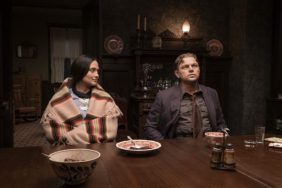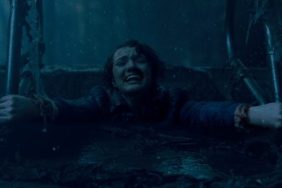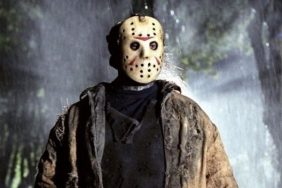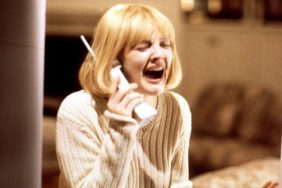Scream 4 is coming out this weekend, so guess what we’re talking about…? Yes, the Slasher movie. Long the black sheep of even horror cinema, this amusing little subgenre about attractive people getting murdered by maniacs with grudges wearing masks finally garnered some critical attention thanks to Wes Craven and Kevin Williamson’s smart satire Scream in 1996, which acknowledged the oft-chided conventions of the genre while calling into question their supposed cheesiness.
But oh, what cheesiness there used to be! The low-budget nature of the Slasher meant that any Tom, Dick or Harry could pump one out, even back in the days when they had to be shot on 35mm film. The result was a deluge of often stupid movies in which the protagonists were so badly written and acted that the supposed villains of the films became the heroes, quietly ridding the screen of all the annoying human-shaped distractions. Many of these Slasher movies have obvious entertainment value, but calling them ‘good’ would be stretching the definition of that word until it snapped.
So despite decades of entries in the Slasher genre, picking what we consider the 10 Best Slasher Movies was relatively easy, particularly once we narrowed our field to non-supernatural villains. Films like A Nightmare on Elm Street, Child’s Play and even the first two great Final Destination movies all contain Slasher elements, but bringing magic into their stories generates an x-factor which sets them apart from good, old fashioned ‘killer in a mask’ flicks. (Just consider them our Honorable Mentions.) These are our choices for the best Slashers in the classic mold.
10. EVIL DEAD TRAP (dir. Toshiharu Ikeda, 1988)

Evil Dead Trap is not a particularly popular movie. In fact, a lot of people consider it a piece of crap. We disagree, and so does acclaimed director Oliver Stone, who contributed a quote to the home video cover calling it “A daring and grim thriller… reveals Japan’s twisted sexual soul one terrifying scene after the other.” We concur. Miyuki Ono (Black Rain) plays Nami, the host of a YouTube-esque television series that plays weird home videos. When one submission looks suspiciously like a snuff film she brings her crew out to the location where it was shot, and one by one they’re all murdered in gruesome death traps a la Saw, or at least they would be a la Saw if Evil Dead Trap didn’t predate it by 16 years. A rough, grungy film but also an intense thriller with a host of unexpected kills and a twist ending which was probably surprising as hell back in 1988, even though audiences these days will probably figure out less than halfway through the film.
9. SILENT NIGHT, DEADLY NIGHT (dir. Charles E. Sellier Jr., 1984)

Many of us remember Silent Night, Deadly Night for its iconic video cover, depicting a snow laden chimney with Santa’s arm sticking out the top, clutching an enormous ax. If you’ve actually seen the film you’re likely to have had one of two reactions: 1) disgust at the film’s sacrilegious depiction of Christmas (Siskel and Ebert reviewed the film on their show, listing the names of the crew and saying ‘shame, shame, shame’ after each one), or 2) glee at the awesome insanity of it all. A little boy is on a trip to see his grandfather at a mental institution where the spooky old guy tells him that Santa Claus doesn’t just reward the good, but also kills the naughty. That’s enough to give any kid a complex, but it gets worse: by sheer blind stupid chance his parents are murdered on the way home by a guy in a Kris Kringle outfit. Years later the guy has a terrifying fear of Christmas, which is exacerbated when he’s forced to play Santa at the toy store where he works. He quickly snaps and goes on a killing spree around town, decapitating sledders and impaling naked lasses on reindeer horns. A low-budget film and a pretty cheesy one, but the incredibly screwed up premise and a host of gruesome sleighings (ha) make it one of the best ‘bad’ Slashers ever made.
8. OPERA (dir. Dario Argento, 1987)

The Italian ‘Giallo’ genre isn’t quite the same as the American Slasher, but they’re closely related. The works of Dario Argento, Mario Bava and their contemporaries were an obvious influence on the Slasher genre as it came to prominence in the late 1970’s. They also focus on serial murderers who gruesomely murder their victims in elaborate ways, but the plot usually revolves around people investigating the crimes over a long period, rather than on a group of unsuspecting individuals getting murdered in a brief, exciting spree. Giallo maestro Argento (try saying that five times fast) made at least one great film that fits both molds: Opera, about a talented ingénue whose biggest fan repeatedly ties her up and tapes pins to her eyelids, keeping them open as he brutally murders her friends and co-workers in front of her. It’s an unsettling concept and an extremely screwed up film, but masterfully made all the way through a dazzling climax which involves a swarm of crows tracking down the killer in a crowded theater. Then the actual last scene of the film inexplicably moves to Switzerland for a completely unnecessary denouement. Ignore the ending and enjoy the Slasher classic that precedes it.
7. BEHIND THE MASK: THE RISE OF LESLIE VERNON (dir. Scott Glosserman, 2006)

A clever deconstruction of the Slasher genre, Behind the Mask: The Rise of Leslie Vernon boasts what should by all rights be an insufferable concept, in which a group of film students make a documentary about a real-life Slasher. What they discover is that when he’s not killing teenagers, this Leslie Vernon (Nathan Baesel of TV’s Invasion) is actually a charming fellow who regards his vocation with both passion and respect. Revealing the nuts and bolts behind the accepted clichés – Leslie visits the scene of the crime beforehand to replace all the batteries in the flashlights with dying ones, and weaken tree branches to assure that his victims will fall if they try to escape via an upstairs window – Behind the Mask is little more than a clever exercise until a bravura finale kicks it into high gear and the documentarians find themselves on the receiving end of Vernon’s craft. Not just a smart comedy but also an intelligent commentary on horror audiences who like the killers more than their victims, one that forces the viewer to question the very desensitization that makes the concept work in the first place.
6. CHERRY FALLS (dir. Geoffrey Wright, 2000)

One of the more familiar clichés in the Slasher genre is that only virgins survive the film, in some half-hearted nod to morality that is presumably intended to compensate for the gleeful depiction of immorality that surrounds it. Geoffrey Wright’s smart and exceptionally well-made Cherry Falls subverts this concept with a serial killer who only kills virgins. The adults of the film try to keep this fact from their darling teenagers but word eventually gets out and the finale of the film takes place at a blockbuster orgy designed to take all the hapless kids off the ‘endangered species list.’ Cherry Falls is one of the most sexually charged non-pornographic movies ever made. Every single interaction between the cast of characters feels like a seduction, even between the late Brittany Murphy’s character and her father the sheriff, played by Terminator’s Michael Biehn. When he sits by his hot daughter’s bedside and asks ‘How far you’ve gone’ and then asks, hopefully, ‘Can you go further?’ the film skillfully walks the thin line between campiness and creepiness. One of the best movies to emerge from the post-Scream surge in Slasher popularity, Cherry Falls sadly went straight to video, keeping it relatively unknown to this day.
5. SLEEPAWAY CAMP (dir. Robert Hiltzik, 1983)

Just as sexually charged as Cherry Falls but about five times creepier is Robert Hiltzik’s Sleepaway Camp, in which an unseen psychopath horrifically murders the youngsters at a summer camp. The first time you watch Sleepaway Camp it’s actually hard to tell if the movie is brilliant or awful: the acting is arch, the costumes are bizarrely provocative (even for the men) and it uncomfortably sexualizes even the youngest characters. By the film’s unforgettable ending you realize that those choices were all intentional, and represent the killer’s skewed perspective, which stems from their own deep-seated sexual confusion and thoroughly bizarre upbringing. And we’re not kidding about that ending. It’ll screw with your head for days.
4. FRIDAY THE 13TH PART 2 (dir. Steve Miner, 1981)

There’s a scene in Scream 2 in which the characters struggle to think of a movie sequel that surpasses the original. Surprisingly, not a one of them thinks to point out that Friday the 13th Part 2 is superior to the first film in every single respect. Better acted, smartly written and with infinitely superior kills, this sequel literally treats the plodding original as a spooky campfire story before the camp counselors at Crystal Lake discover to their horror that it was all true. The film that first introduced Jason Voorhees into the public consciousness – before he turned into a zombie and even before his famous hockey mask – Friday the 13th Part 2 remains the best ‘serious’ entry in the series, and holds up incredibly well to this day.
3. BLACK CHRISTMAS (dir. Bob Clark, 1974)

Considered by many to be the first ‘true’ Slasher flick (after Michael Powell’s Peeping Tom, Alfred Hitchcock’s Psycho and the Italian Giallo genre paved the way, of course), Bob Clark’s Black Christmas remains one of the creepiest Slasher movies ever crafted. An unseen killer stalks and murders the girls of a sorority who have no idea that he/she/it secretly lives in their own house and makes disturbing phone calls to his/her/its nubile roommates. The stellar cast includes Superman’s Margot Kidder and Romeo and Juliet’s Olivia Hussey, and the director was Bob Clark, who would go on to become the director of such classic family fare as A Christmas Story, and such less-than-classic family fare as Baby Geniuses 1 and 2. A subtler film than most of the Slasher movies it spawned, with an eerily ambiguous ending that left room for a sequel which (perhaps mercifully) was never made.
2. SCREAM (dir. Wes Craven, 1996)

Scream is a truly great movie, satirizing the conventions of the Slasher genre whilst simultaneously functioning as a perfect example of the genre, and somehow paying direct homage to its inspirations without ever feeling unoriginal. A serial killer in a mask patterned after Edvard Munch’s painting Scream starts murdering teenagers in the town of Woodsboro, California, and patterns their homicides after famous killings from movies ranging from When a Stranger Calls to Suspiria. The film brilliantly examines not only the conventions of the Slasher but also typified an entire generation of American youths to whom popular culture is more influential than ‘actual’ culture. An unusually well-written cast of characters elevates the already high-minded material beyond a mere genre entry, spawning a series of sequels as interested in developing its protagonists throughout their lives as it is in murdering teenagers… which is to say a lot.
1. HALLOWEEN (dir. John Carpenter, 1978)

While not the first Slasher film, John Carpenter’s razor sharp Halloween codified the genre and its enormous success directly influenced the Slasher’s sudden surge in popularity in the 1980’s. (Its ratio of cost to profit still makes it one of the most profitable movies ever made). A little boy puts on a mask one Halloween and murders his sister. When the mask is removed the boy’s face is completely expressionless, his mind hollow of emotion. What his psychiatrist Dr. Loomis (the great Donald Pleasance) discovers, to his horror, is that this Michael Myers simply has no soul, just a purpose: to kill. When he escapes his mental institution years later he embarks on an icy rampage throughout his old neighborhood, quietly slaughtering a litter of unsuspecting teenagers. Outside of a few memorable steadicam shots, Carpenter’s cinematic restraint is almost unthinkable: the film moves like a shark, gliding from one tragic (and relatively bloodless) death to the next, pausing only to milk palpable suspense at key intervals. Like its predecessor Black Christmas, Carpenter gave his film an ambiguous ending intended to unsettle his audience, not spawn a series of disappointing sequels (which is of course exactly what happened). The less said about Rob Zombie’s remake the better. Halloween is the best Slasher ever made.






